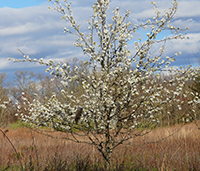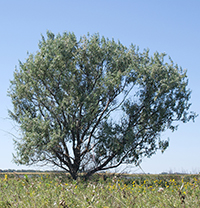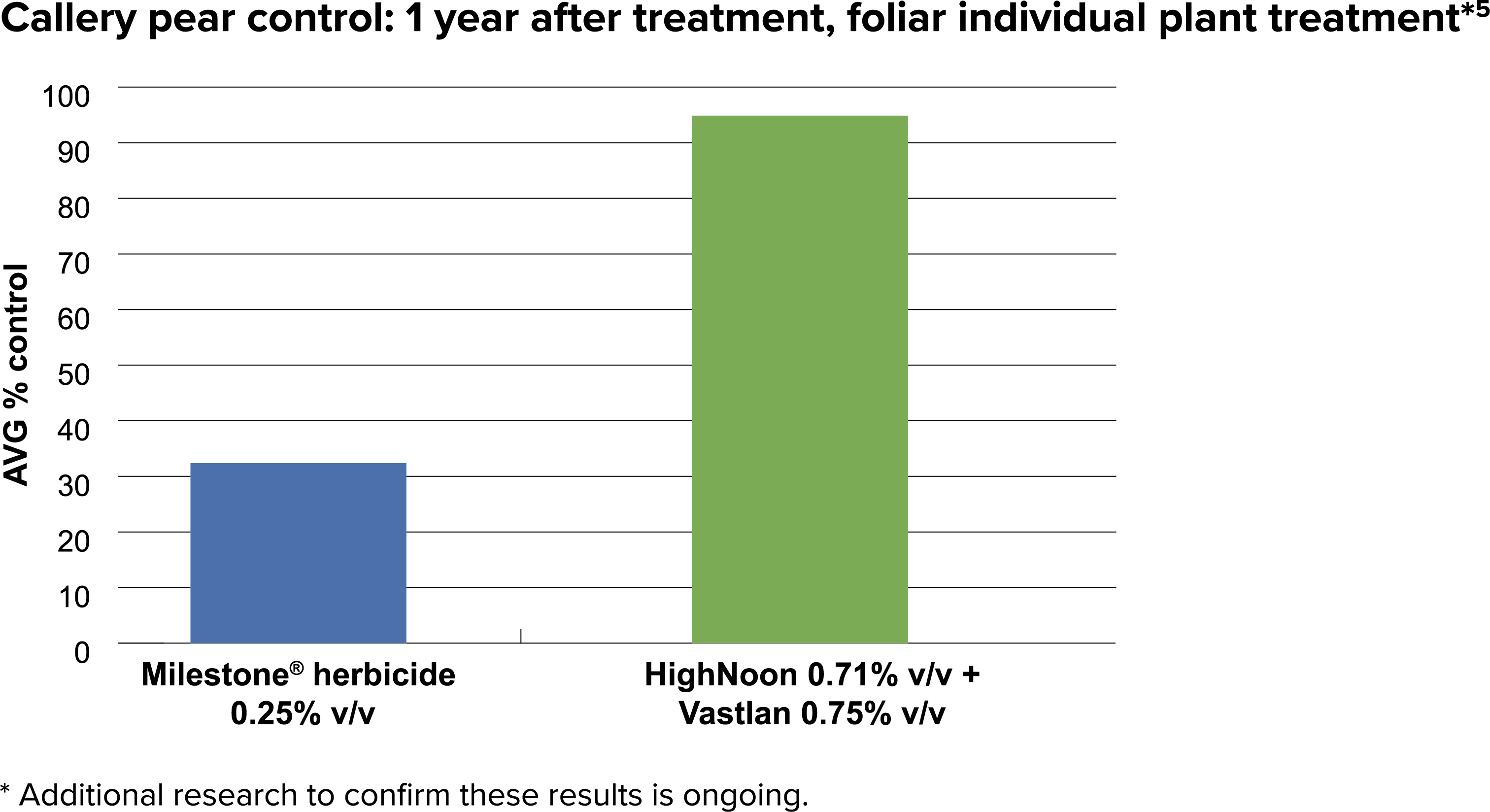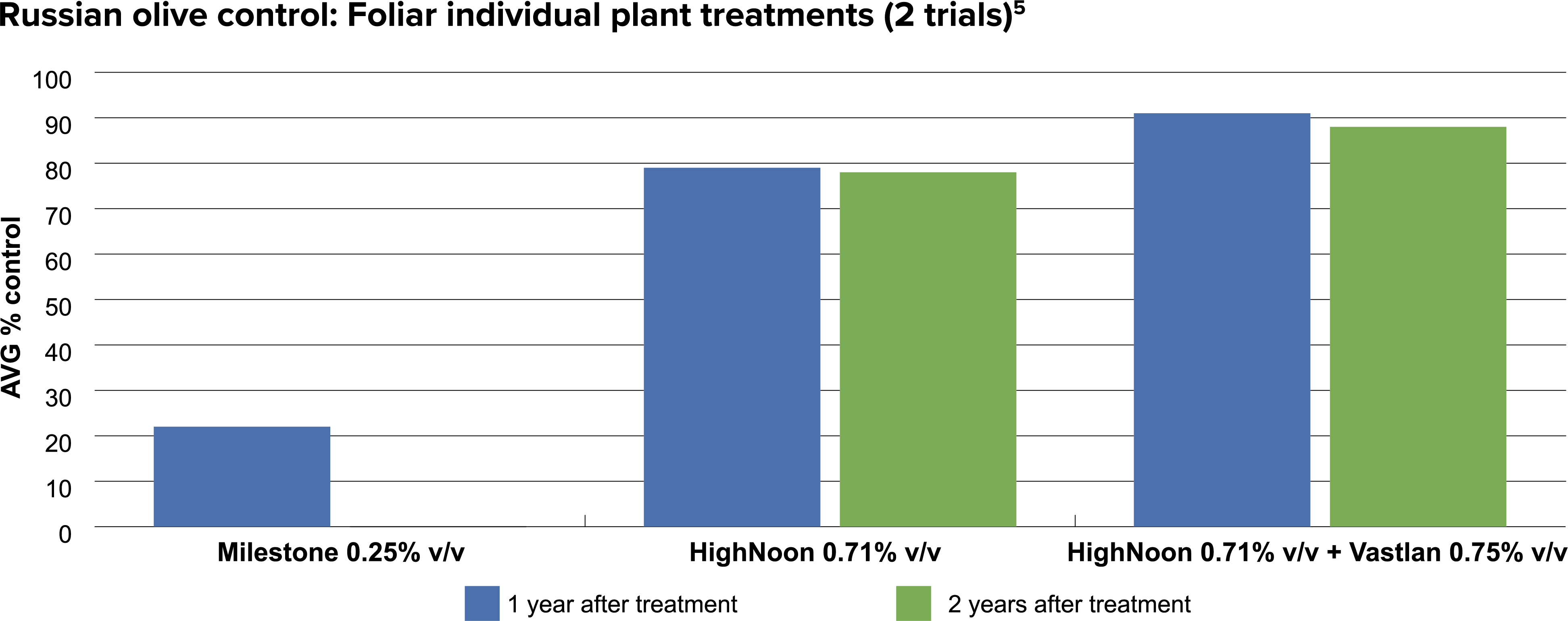Tools to Fight Callery Pear and Russian Olive

Invasive plant species like callery pear and Russian olive present ongoing challenges for land managers, as they have limited natural controls and can outcompete native vegetation. Their presence in open areas can alter the landscape and reduce water and habitats for native wildlife. Traditional methods of control include physical removal or the use of nonselective herbicides on young plants or cut stumps. These methods are considered less than ideal due to the labor involved and the potential for damage to off-target desirable grasses and plants.
However, new herbicides and management strategies may be able to improve how land managers combat these invasive woody species while reducing labor costs and protecting desirable plant species.
 The callery pear — or Pryus calleryana — was originally brought to the U.S. from Asia in the early 1900s as part of an attempt to fight the fire blight damaging common pear trees.1 The medium-sized tree is often planted ornamentally for its flowers and foliage.
The callery pear — or Pryus calleryana — was originally brought to the U.S. from Asia in the early 1900s as part of an attempt to fight the fire blight damaging common pear trees.1 The medium-sized tree is often planted ornamentally for its flowers and foliage.
Callery pear is fast-growing and can be easily spread by birds consuming its fruit. This combination allows the tree to encroach on open spaces, including grasslands, pastures and non-crop areas, where it is capable of establishing woodland. It forms dense thickets in formerly open areas and shades out native plants, altering habitats for wildlife. It also can grow along roadways, where it limits sightlines and attracts deer — increasing the risk of traffic accidents.
 The Russian olive — or Elaeagnus angustifolia L. — presents as a shrub or small tree that can reach about 10 meters in height.2 Young plants are silvery, but turn brown with age, and plants can be thorny and covered in scales. The tree generates spring flowers and seeded fruit.
The Russian olive — or Elaeagnus angustifolia L. — presents as a shrub or small tree that can reach about 10 meters in height.2 Young plants are silvery, but turn brown with age, and plants can be thorny and covered in scales. The tree generates spring flowers and seeded fruit.
Russian olive poses a threat to native species, especially in the western U.S., where it is considered an invasive species and can be listed as a noxious weed. It is able to outcompete native species like the Plains cottonwood and grows well in riparian areas.
Once Russian olive establishes itself in an area, it can interrupt the growth and spread of native plant species and nutrient cycling. It also can outcompete native plants for scant water resources — especially in western regions.3 The plant grows in a variety of soils including bare, mineral substrates and in shaded areas. By generating dense copse, the Russian olive also can present a challenge to ranchers herding cattle and it provides only fair to poor nutritional content for cattle.4
Russian olive and callery pear have traditionally been controlled with a combination of mowing or cutting — typically involving a brush mower or chainsaw — followed by physical removal.1,3 These methods can be time consuming, labor intensive, challenging to employ on large areas and have the potential to damage or kill surrounding vegetation. Callery pear trees that are less than six inches in diameter can be killed using the basal bark method, or herbicides can be applied to the stump of a tree once it has been cut down. However, the most effective herbicides tend to kill wanted vegetation along with the callery pear or Russian olive, allowing for the growth of additional weeds rather than desirable grasses.
 The newly approved HighNoon® herbicide with Rinskor® active aims to help land managers fight back against aggressive invasive species like callery pear and Russian olive. The herbicide includes Rinskor — the first new active ingredient intended for use in pastures and rangelands in almost 15 years. The herbicide contains aminopyralid and a new class of synthetic auxin chemistry — florpyrauxifen-benzyl. Both components are EPA Reduced Risk pesticides. The herbicide functions by binding to specific auxin receptors and has a different use rate, molecular interaction and control spectrum than other auxin-based herbicides.
The newly approved HighNoon® herbicide with Rinskor® active aims to help land managers fight back against aggressive invasive species like callery pear and Russian olive. The herbicide includes Rinskor — the first new active ingredient intended for use in pastures and rangelands in almost 15 years. The herbicide contains aminopyralid and a new class of synthetic auxin chemistry — florpyrauxifen-benzyl. Both components are EPA Reduced Risk pesticides. The herbicide functions by binding to specific auxin receptors and has a different use rate, molecular interaction and control spectrum than other auxin-based herbicides.
HighNoon is effective against more than 140 species of unwanted pasture and rangeland plants and is initially demonstrating enhanced control on select species of woody plants like callery pear and Russian olive. The herbicide also can be combined with others, including Vastlan® herbicide, Garlon® 4 Ultra herbicide, Arsenal and Rodeo® herbicide to improve its ability to combat woody brush plants and weeds while protecting desirable vegetation.
When addressing woody plants like callery pear or Russian olive, HighNoon can be used in a low-volume foliar application. Targeted plants should receive uniform coverage on foliage, stems and root collars. However, the use of HighNoon is unlikely to leave a crater or bare spots in a treated area, denying a foothold to other unwanted vegetation. Instead, HighNoon provides a grass-safe alternative method of control compared to other herbicides like imazapyr.6 The herbicide can be integrated into a long-term preservation plan for desirable vegetation and provide application flexibility. It also can be mixed with liquid or dry fertilizers before application to improve grass growth following the removal of unwanted plants.
Initial results indicate that combining HighNoon® herbicide with Vastlan® herbicide provides superior results controlling callery pear. The combination treatment may provide multi-year benefits, potentially cutting down on the time and overall cost needed to address the plant.

Initial research results examining the use of HighNoon® herbicide to mitigate or control Russian olive indicate a better response than Milestone® herbicide.5 A comparison trial examined the average percentage of Russian olive plants controlled following the application of Milestone at 0.25% v/v or HighNoon at 0.71% v/v and found, that in the first year following treatment, Milestone provided about 20% control while HighNoon controlled about 80% of the plants.5 In the second year of the trial, Milestone was not reported to provide any control, while HighNoon maintained a level of management similar to the previous year.5 Additionally, control of Russian olive in the first year may reach 90% when HighNoon is mixed with Vastlan® herbicide (triclopyr), with control continuing at about 85% in the second year.
HighNoon can also be applied to an area once Russian olive plants are removed to help impede regrowth of the plant6.


Previous methods used to manage callery pear and Russian olive tended to be time consuming, difficult or damaging to desirable vegetation. Removing all plants from an area, while reducing the threat posed by the invasive trees, provides an opportunity for other unwanted weeds to colonize the open ground.
However, new, more selective herbicides are providing pasture and rangeland managers new ways to address the problem of challenging invasive species like callery pear and Russian olive while supporting the growth of native grasses and the fodder they provide.
References:
1 Elmore, Dwayne. “The Invasive Callery Pear.” Oklahoma State University Extension, 2019, https://extension.okstate.edu/fact-sheets/the-invasivecallery-pear.html.
2 “Russian olive.” Center for Invasive Species and Ecosystem Health. https://www.invasive.org/browse/subinfo.cfm?sub=3022.
3 “Least Wanted: Russian Olive.” Plant Conservation Alliance’s Alien Plant Working Group. https://www.invasive.org/alien/fact/elan1.htm.
4 Zouhar, Kris. “Elaeagnus angustifolia. In: Fire Effects Information System,” [Online]. U.S. Department of Agriculture, Forest Service, Rocky Mountain Research Station, Fire Sciences Laboratory (Producer). 2005. Available: https://www.fs.fed.us/database/feis/plants/tree/elaang/all.html [ ].
5 Corteva Agriscience. Product comparisons. Data on file.
6 Corteva Agriscience. Field observations. Data on file.
Hay from grass treated with HighNoon® within the preceding 18 months can only be used on the farm or ranch where the product is applied unless allowed by supplemental labeling. The herbicide will kill legumes including red and white clover. However, white clover will return naturally and removing weed competition can allow for forage to be seeded with higher-yielding legume species. Under normal field conditions, HighNoon is non-volatile. HighNoon and Milestone have no grazing or haying restrictions for any class of livestock, including lactating dairy cows, horses (including lactating mares) and meat animals prior to slaughter. Label precautions do apply to forage treated with HighNoon and Milestone and to manure and urine from animals that have consumed treated forage. When treating areas in and around roadside or utility rights-of-way that are or will be grazed, hayed or planted to forage, important label precautions apply regarding harvesting hay from treated sites, using manure from animals grazing on treated areas or rotating the treated area to sensitive crops. Label precautions apply to forage treated with Milestone and to manure from animals that have consumed treated forage within the last three days. See product labels for details. State restrictions on the sale and use of Garlon 4 Ultra, Garlon XRT and Milestone apply. Consult the label before purchase or use for full details. HighNoon, Milestone and Vastlan are not registered for sale or use in all states. Contact your state pesticide regulatory agency to determine if a product is registered for sale or use in your state. Always read and follow label directions. Arsenal is a registered trademark of BASF.
Sharing innovative research, success stories and tips with invasive plant managers.